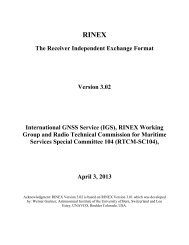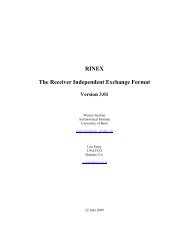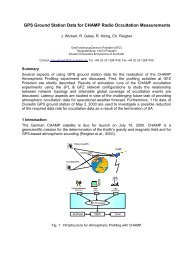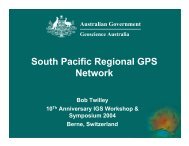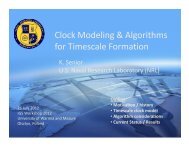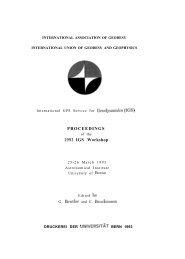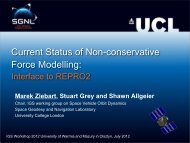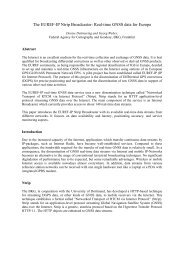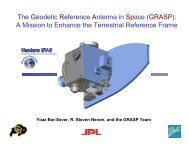IGS Analysis Center Workshop - IGS - NASA
IGS Analysis Center Workshop - IGS - NASA
IGS Analysis Center Workshop - IGS - NASA
Create successful ePaper yourself
Turn your PDF publications into a flip-book with our unique Google optimized e-Paper software.
the 1992 regional <strong>IGS</strong> and lrian Jaya set) positions and velocities of the Irian Jaya stationswere estimated with respect to ITRF91 and the NNR plate motion model [Argus andGordon; 1990] (Figure 9). This approach allows us to integrate solution files from otherexperiments performed in Indonesia and surrounding areas in a similar straightforwardmatter [Calais et al., 1993]. We have done this, for example, for a series of annualmeasurements across the Java Trench between Christmas Island and Java [Tregoning et al.,1993] and in thq Flores Sea [Genr-ich e? al., 1993],It is clear that with this approach diverse regional experiments taken at different timeperiods with a total of hundreds of stations can be combined in a uniform manner withrespect to ITRF. Solution files can be exchanged between different analysis groups todevelop a coherent picture of tectonic motion over a larger region than any one projectprovides. As long as the underlying physical models are not changed, the solution files canbe analyzed many times as the ITRF improves with time. This is an example of distributedprocessing within the context of a single global <strong>IGS</strong> solution.Scenario 3. There are two regional clusters in California for continuously monitoringcrustal deformation, a southern California array and a northern California array, each of 20stations. Each array does its own regional analysis. The southern California array acquiresthe clean RINEX data from the <strong>IGS</strong> analysis center which are analyzed simultaneously withtwo of the regional stations, producing expanded solution files. In a separate analysis thecomplete set of southern California stations are adjusted together with two stations of thenorthern California array. Thus the southern California analysis center produces two setsof solution files. The northern California analysis center analyzes all data from its ownarray including the overlapping stations analyzed by its southern California counterpart andproduces another set of solution files. All three sets of solution files can then be input to aGLOBK-type program to produce a daily set of coordinate solutions for both southern andCalifornia arrays, with tight constraints applied to the global <strong>IGS</strong> stations..To demonstrate this concept, we refer again to Blewitt et al. [1993] and Bock et al. [ 1993].Both analysis groups were able to determine “absolute” displacements of the PGGAstations using different software, processing algorithms and physical models,demonstrating that distributed processing is feasible. Both groups analyzed the PGGA and<strong>IGS</strong> data simultaneously. However, at some point the number of PGGA and <strong>IGS</strong> stationswill grow to a point that it will not feasible or efficient to continue to do this. Therefore,we test whether we could have obtained the same results using a distributed processingapproach. The Landers data were re-adjusted in two steps using the clean RINEX datafrom the original analysis in which both data sets were adjusted simultaneously [Zhang,1993]. In the first step, the data set that included the entire <strong>IGS</strong> global data set was readjustedsimultaneously with data from two PGGA stations (DS 10 and JPL1 ) generating adaily solution file for the five weeks before and after the earthquakes, In a second step, allthe PGGA data (there were 5 stations operational at that time) were adjusted independentlyand simultaneously, generating a second set of solution files. Both sets of solution fileswere analyzed with the GLOBK software using the same station constraints for the global<strong>IGS</strong> stations as in Bock ef al. [1993]. The coseimic displacements estimated from thisdistributed approach were statistically equivalent as indicated in Figure 10.In another test of distributed processing with the PGGA, L.indqwis?er e? al. [1991]analyzed an unbiased selection of 23 daily sets of measurements spanning 8 months in1990. Aimajor concern was that the CIGNET tracking network at that time wasinstrumented with MiniMac 28 16AT receivers and antennas, and the PGGA with RogueSNR-8 receivers. In an attempt to reduce the effect of different phase center variationsbetween the two types of antennas, the data from each network were reduced separately,and then orbital elements were combined (3 epoch positions, 3 velocities, and 3 solar86




